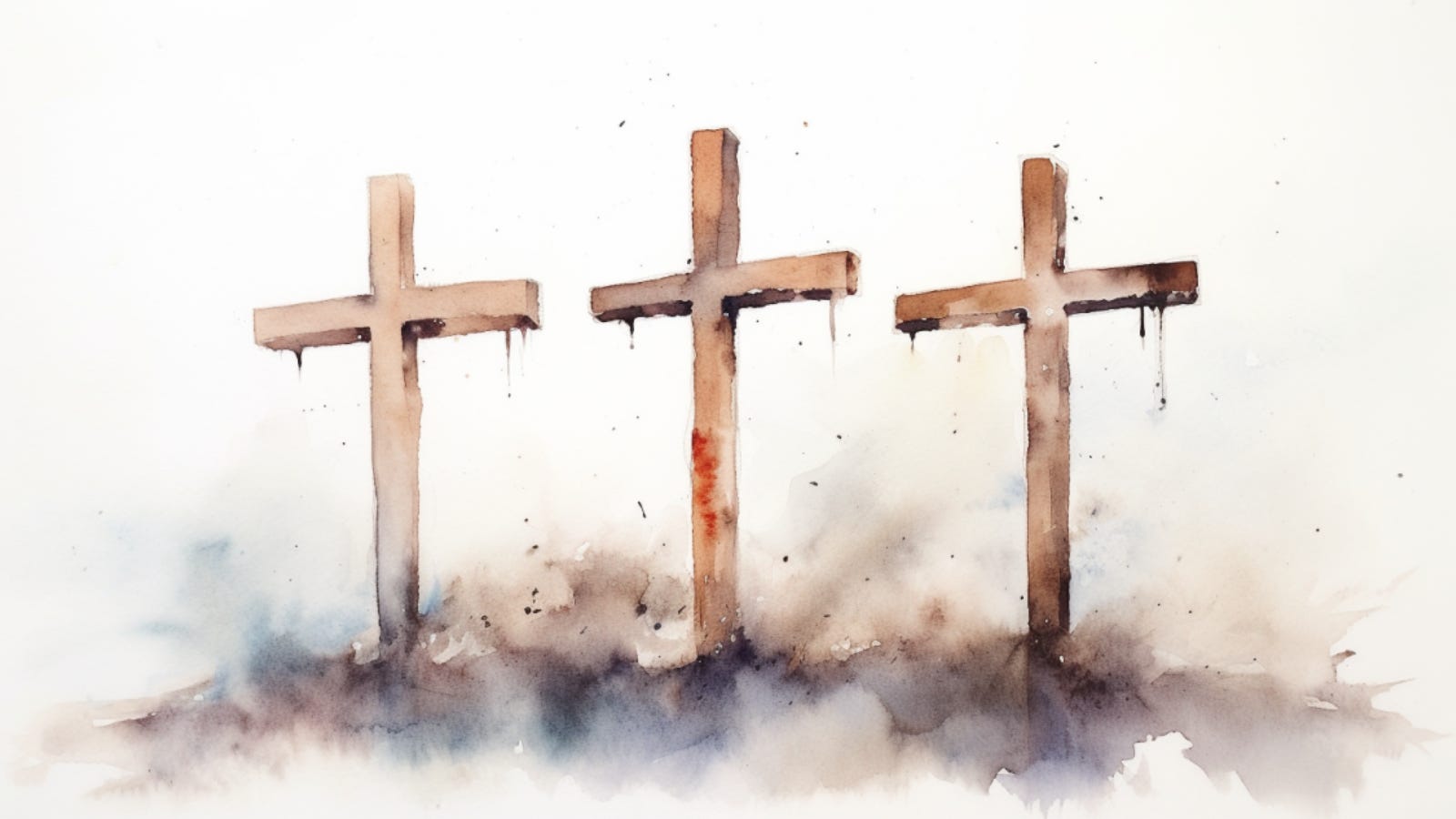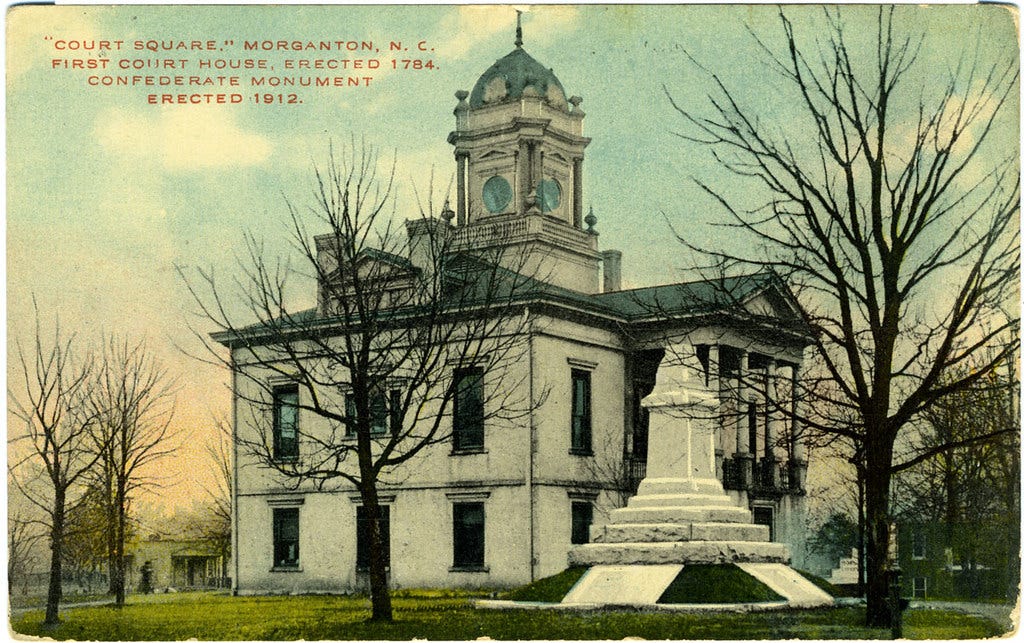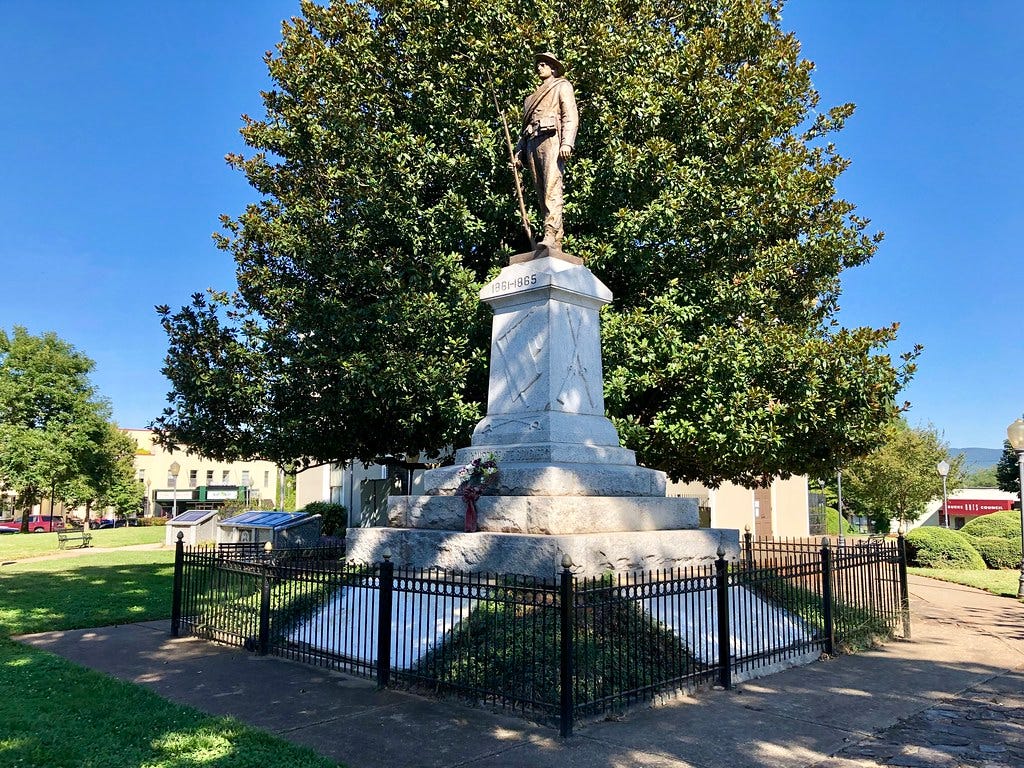Would Christ's Crucifers Remove Monuments to White Supremacy?
Debate over the removal of Burke County's Confederate monument continues, with one speaker comparing activists to Christ's crucifiers.

MORGANTON, NC—The saga regarding the removal of the Confederate monument lording over downtown Morganton from the Historic Burke County Courthouse lawn continues.
During the formal public comments portion of the May 16th County Commissioners’ Meeting, several Burke residents remarked on either their support for the removal or continued display of the Confederate monument.
A Compromise to Removal of the Confederate Monument Is Proposed
Dr. Kenneth Carrico, who identified as “a 16-year resident of Burke County, a former practicing psychologist, and an active member of the Republican Party,” focused his comments on what he called “the long-live controversy surrounding the Civil War memorial.”
While stating he wasn’t going to address “the arguments for or against removing the memorial,” Carrico acknowledged that he “fully support[s] its continued untouched presence on the courtyard square, viewing it as a solemn reminder of lost lives, just like grave markers are in a cemetery, and for that matter, just like the grand Colosseum in Rome is of the suffering and death of Christians in antiquity, neither should be removed or destroyed.”

He went further to propose what he considers “a viable option to resolve this dilemma, which keeps coming up, once and for all.” He recommended that a memorial to “the evils of slavery” should be erected on the Historic Burke County Courthouse square, presumably standing adjacent to the Confederate memorial. He believes this could be funded through donations from residents and local government support.
He then concluded his remarks with what has become, sometimes, an evasive refrain among folks resisting change and, at other times, a much-needed clarion call: “Let’s stop being divisive.”
Legal Barriers to Removing the Confederate Monument
While far from addressing the reality the Confederate monument is a menacing symbol of hatred and racism for many people, his proposal retains the advantage of having no obvious legal challenges, should Burke residents support such an endeavor.
North Carolina State Statute 100-2.1 remains an obstacle to those eager to move past hateful Confederate identities and symbols of white supremacy.
It happened to be passed in 2015 by the NC Legislature, in the weeks following a racially motivated hate crime in South Carolina by a white supremacist that left 9 churchgoers killed. This tragedy reanimated conversations about removing Confederate monuments, and even inspired South Carolina Governor Nikki Haley to sign a law dictating the Confederate Battle Flag be removed from the South Carolina State Capitol.

While South Carolina was making steps forward, North Carolina’s elected officials quietly passed Statute 100-2.1, likely to preempt anticipated efforts in the Tar Heel State to remove Confederate monuments and symbols from public grounds.
This statute means that any object of remembrance on public grounds, such as the Confederate monument in downtown Morganton, “that is permanently relocated shall be relocated to a site of similar prominence, honor, visibility, availability, and access that are within the boundaries of the jurisdiction from which it was relocated.”
In other words, there would be major legal ramifications for removing the Confederate monument that currently torments downtown Morganton unless it’s placed somewhere of equal prominence. Good luck finding a spot in Burke County that is seen by more people than the Historic Burke County Courthouse lawn.
So even though most Morganton residents are eager to remove this painful object from downtown, those eager to make meaningful social progress may be stuck between a rock and a hard place, so to speak.
While it may be viewed as a reasonable compromise in some residents’ eyes, it’s difficult not to see the persistent presence of the Confederate monument as an embodiment of white supremacy that washes out any sense of justice or healing a neighboring memorial to “the evils of slavery” might attempt to convey.
Crucifers of Christ, Confederates, or Christians?
The comments then took a decidedly controversial turn when Burke resident Maynard Taylor addressed the Board.
After detailing the astounding number of casualties from the roughly one dozen wars the United States have been involved in, he seemed to suggest that people who want to remove the Confederate monument might “possibly be the same type of person that demanded Christ should be crucified” while calling for the release of “a really bad criminal.”
It’s been observed by many philosophers and scholars of religion that the meaning of the Bible—and any scripture for that matter—is routinely negotiated and renegotiated by people in particular places to help them address the needs and challenges of specific communities. In other words, there is no inherent meaning in scripture, save that which we imbue it with ourselves.
It is for us to discuss and decide which interpretations are more justified by the text.
To support this line of thought, we need look no further than the wildly diverse and conflicting ways in which Christian scripture has been used both to defend and denounce the Confederate Cause and its peculiar institution (chattel slavery). While Mr. Taylor is continuing that practice of arbitrating the meaning of Christ’s crucifixion, as recounted in the New Testament, I’m confident many self-identified Christians would reject his interpretation outright.
In fact, just an hour prior to the County Commissioners’ Meeting, the Burke Coalition for Reconciliation (BCfR) met in Pastor George Logan’s New Day Christian Church to discuss racial equity and the power “proximity” has to help us learn from each other and right the racial injustices in our community. Speaking on behalf of BCfR, Sam Avery used a few minutes during the County Commissioners’ Meeting to recap some of what was shared during the gathering at Pastor Logan’s church.
Roughly 30 people met in the New Day Christian Church to rewatch and discuss the 2023 Spring Commencement speech given by Bryan Stevenson at the University of North Carolina-Chapel Hill. Among other things, Stevenson touched on the concept of “doing uncomfortable things” and getting in close “proximity” with those who are marginalized or different from us.
“I believe that we're going to be judged as graduates of this university not for the things that we do for the rich and the powerful and the privileged,” he said. “I think we're ultimately going to be judged by what we do for that greater public that has made it possible for us to be here. So, to all of you who embrace the challenge of getting proximate to the excluded and the disfavored, all of you who want to change the narratives and push back against fear and anger, all of you who will stay hopeful, all of you who will do the uncomfortable things that our world desperately needs you to do, I just want to say to each and every one of you, ‘Keep on keeping on,’ and we're going to be celebrating everything you do every step of the way.”
Founded by Stevenson in 1989, the Equal Justice Initiative reports that more than 4,400 people were lynched in the United States during the period between Reconstruction and World War II. Highlighting this reign of racial terror and pleading for reconciliation with our community’s racist past and unjust present, Avery (whose family members’ name adorn the Confederate monument) drew attention to the two documented lynchings that occurred here in Burke County.
It is no coincidence that the body of one of those individuals who was lynched in the foothills of the Blue Ridge Mountains was then placed at the base of the Confederate monument downtown.
If the Confederate monument does, in fact, have little to do with white supremacy or hate, and is merely a memorial to so-called “heritage” or the lives of Confederate soldiers lost during the Civil War, then why would perpetrators of this lynching choose to put evidence of their cruel deeds at its feet? What message were they sending to Christians in our community? What were they saying about the significance of that monument to the “excluded” and “disfavored”?
I won’t go so far as to opine as to whether I think supporters of the Confederate Cause or the continued presence of Confederate memorials would have crucified Christ had they lived during ancient times.
However, I do believe history will side with those Christians who take the words of Luke 4:18 (KJV) to heart—as Seth Collings Hawkins eloquently expressed in a recent op-ed for the Morganton News Herald—”The Spirit of the Lord is upon me, because he hath anointed me to preach the gospel to the poor; he hath sent me to heal the brokenhearted, to preach deliverance to the captives, and recovering of sight to the blind, to set at liberty them that are bruised.”
It is certain many more members of BCfR will chronicle before the Burke County Commissioners Board their continued efforts to “pro-actively build a community of love, justice, and reconciliation,” as the BCfR mission states.
Change comes slowly, but if the County Commissioners don’t know it by now, these calls for action aren’t going away anytime soon.




